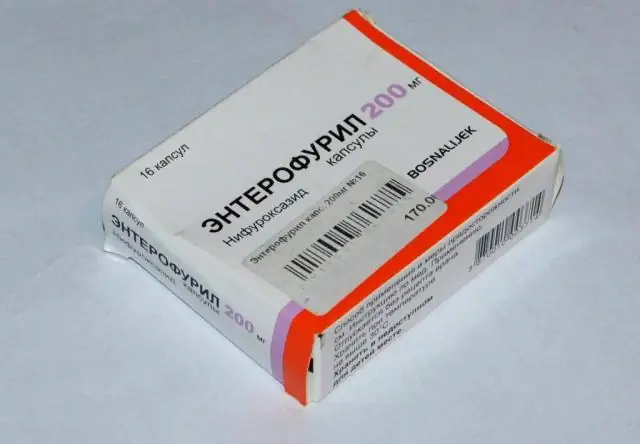- Author Rachel Wainwright [email protected].
- Public 2023-12-15 07:39.
- Last modified 2025-11-02 20:14.
Katena
Katena: instructions for use and reviews
- 1. Release form and composition
- 2. Pharmacological properties
- 3. Indications for use
- 4. Contraindications
- 5. Method of application and dosage
- 6. Side effects
- 7. Overdose
- 8. Special instructions
- 9. Application during pregnancy and lactation
- 10. Use in childhood
- 11. In case of impaired renal function
- 12. Drug interactions
- 13. Analogs
- 14. Terms and conditions of storage
- 15. Terms of dispensing from pharmacies
- 16. Reviews
- 17. Price in pharmacies
Latin name: Katena
ATX code: N03AX12
Active ingredient: gabapentin (gabapentin)
Manufacturer: BELUPO, medicines and cosmetics dd (Croatia)
Description and photo update: 2018-21-11
Prices in pharmacies: from 473 rubles.
Buy

Katena is an antiepileptic drug.
Release form and composition
Katen's drug is produced in the form of capsules: in a dosage of 100 mg - size No. 3, white; at a dosage of 300 mg - size No. 1, yellow; at a dosage of 400 mg - size No. 0, orange; the contents of the capsules are white crystalline powder (100 mg capsules - 10 pcs. in blisters, in a cardboard box 2 blisters; capsules 300 and 400 mg - 10 pcs. in blisters, in a cardboard box 5 blisters).
Composition of one capsule:
- active substance: gabapentin - 100, 300 or 400 mg;
- auxiliary components: corn starch, lactose monohydrate, talc;
- capsule shell: gelatin, titanium dioxide (E 171), as well as iron dye yellow oxide E 172 (in capsules 300 mg), iron dye yellow oxide E 172 and iron oxide red E 172 (in capsules 400 mg).
Pharmacological properties
Pharmacodynamics
The active ingredient in Katena is gabapentin, a substance similar in structure to the neurotransmitter gamma-aminobutyric acid (GABA). However, its mechanism of action differs from that of some other drugs that interact with GABA receptors, including barbiturates, GABA uptake inhibitors, GABA agonists, valproate, GABA transaminase inhibitors, benzodiazepines, and GABA prodrugs, since gabapentin does not have GABAergic properties, does not affect the metabolism and capture of GABA.
According to preliminary studies, gabapentin binds to the α 2 -δ subunit of voltage-dependent calcium channels and suppresses the flow of calcium ions, which is one of the causes of neuropathic pain.
In addition, in neuropathic pain, gabapentin has other mechanisms of action, namely: it reduces glutamate-dependent neuronal death, increases GABA synthesis, and inhibits the release of monoamine group neurotransmitters.
At clinically significant concentrations, the drug does not bind to the receptors of other common drugs and neurotransmitters, including benzodiazepines, glutamate, glycine, N-methyl-D-aspartate, GABA A and GABA B receptors.
Unlike carbamazepine and phenytoin, gabapentin does not interact with sodium channels.
Pharmacokinetics
After taking Katena inside, the maximum concentration of gabapentin in plasma is observed after 2-3 hours. The bioavailability of the drug is approximately 60%, it is not proportional to the dose (with an increase in the dose, bioavailability decreases).
Foods, including fatty ones, have no effect on the pharmacokinetics of gabapentin.
Elimination of the drug from the body is well described using a linear model.
With repeated doses, the pharmacokinetics of gabapentin does not change. Equilibrium plasma concentrations can be predicted from the results of a single dose of Katena.
It is characterized by low binding to plasma proteins - less than 3%. The volume of distribution is 57.7 liters.
No signs of drug metabolism were found in humans. Gabapentin does not induce mixed liver oxidative enzymes that are involved in drug metabolism.
The withdrawal period is on average 5-7 hours and does not depend on the dose taken. The drug is excreted unchanged by the kidneys.
Excretion of gabapentin from plasma is reduced in patients with impaired renal function and in the elderly. Renal clearance, plasma clearance, and elimination rate constant are directly proportional to creatinine clearance. Gabapentin is eliminated by hemodialysis. In case of impaired renal function and hemodialysis, a dose adjustment of Katena is required.
Plasma concentrations of gabapentin in children 4-12 years of age are approximately the same as in adults.
Indications for use
- neuropathic pain in adult patients (over 18 years of age);
- partial convulsions in epilepsy, including with secondary generalization, in adults and adolescents from 12 years old - as monotherapy;
- partial convulsions in epilepsy, including with secondary generalization, in adults and children from 3 years of age - as an additional agent as part of complex therapy.
Contraindications
According to the instructions, Katena is strictly contraindicated in children under 3 years of age, as well as in all patients if they have hypersensitivity to any component of the drug.
Patients with renal insufficiency should be treated with caution.
Instructions for use of Katena: method and dosage
The capsules should be taken orally regardless of meals. It is necessary to reduce the dose, cancel Katena or replace it with an alternative remedy gradually, over a period of at least one week.
With neuropathic pain in adults, the initial daily dose is 900 mg - 300 mg 3 times a day. If the effect is insufficient, the dose is gradually increased. The maximum allowable daily dose is 3600 mg.
You can immediately start treatment with a daily dose of 900 mg, or gradually increase it during the first three days according to the following scheme:
- the first day - 300 mg once a day;
- the second day - 300 mg 2 times a day;
- the third day - 300 mg 3 times a day.
With partial seizures in adults and adolescents from 12 years old, Katena is effective in the range of daily doses of 900-3600 mg. You can immediately start treatment with a daily dose of 900 mg (300 mg 3 times a day) or gradually increase it during the first three days according to the scheme described above. In the future, if necessary, the dose is continued to increase, up to a maximum daily dose of 3600 mg (in equal parts in 3 divided doses). The interval between doses should not be more than 12 hours, as there is a risk of seizures recurrence. Good tolerance of gabapentin in daily doses up to 4800 mg was noted.
In case of partial convulsions in children 3-12 years old, Katena is prescribed in an initial daily dose of 10-15 mg / kg in 3 divided doses. The dose is gradually increased over about 3 days until the most effective dose is reached. In children over 5 years old, it is usually 25-35 mg / kg / day, in children 3-5 years old - 40 mg / kg / day (in 3 divided doses). With long-term use, gabapentin is well tolerated in daily doses up to 50 mg / kg. To avoid the resumption of seizures, the interval between doses should not exceed 12 hours.
It is not necessary to control the concentration of the drug during treatment. Katena can be used in combination with other anticonvulsants without taking into account changes in serum drug concentrations.
For patients with renal insufficiency, the daily dose of Katena is determined depending on the creatinine clearance (CC, ml / min):
- more than 80 - 900-3600 mg;
- 50-79 - 600-1800 mg;
- 30-49 - 300-900 mg;
- 15-29 - 150 * -600 mg;
- less than 15 - 150 * -300 mg.
* Assign Catena 300 mg every other day.
For patients who have not previously used gabapentin and are on hemodialysis, Katena is prescribed in a saturating dose of 300-400 mg, then 200-300 mg is used every 4 hours of a hemodialysis session.
Side effects
- from the nervous system: hyperkinesia, hypesthesia, fatigue, asthenia, ataxia, tremor, insomnia, drowsiness, anxiety, impaired coordination, emotional lability, dizziness, dysarthria, nystagmus, impaired thinking, confusion, nervousness, depression, hostility, amnesia, as well as weakening, strengthening or absence of reflexes;
- from the digestive system: dry mouth or pharynx, dental disease, gingivitis, dyspepsia, constipation, diarrhea, increased appetite, abdominal pain, nausea, vomiting, flatulence, anorexia, increased activity of hepatic transaminases;
- from the cardiovascular system: hypertension, symptoms of vasodilation;
- from the respiratory system: rhinitis, pharyngitis, respiratory infections, cough, shortness of breath, bronchitis, pneumonia;
- on the part of the musculoskeletal system: increased fragility of bones, back pain, myalgia, arthralgia;
- on the part of the hematopoietic organs: purpura (most often it is described as bruising arising from physical injury), leukopenia;
- from the genitourinary system: urinary tract infections, impotence;
- from the senses: amblyopia, visual impairment, diplopia;
- allergic reactions: itching, skin rash, acne;
- others: headache, pain of various localization, weight gain, viral infection, fever, facial edema, peripheral edema.
The post-registration data describes the following side effects: alopecia, allergic reactions (including urticaria), generalized edema, angioedema, acute renal failure, increased liver function parameters, pancreatitis, tinnitus, movement disorders (such as dyskinesia, dystonia, choreoathetosis), chest pain, palpitations, urinary incontinence, thrombocytopenia, myoclonus, hallucinations, erythema multiforme (including Stevens-Johnson syndrome), an increase in the volume of the mammary glands, gynecomastia, fluctuations in blood glucose concentration in patients with diabetes mellitus. There are isolated cases of sudden death, but their relationship with the use of gabapentin has not been reliably established.
Overdose
Symptoms: speech impairment, double vision, dizziness, diarrhea, drowsiness, lethargy.
Gastric lavage and the intake of activated charcoal are recommended, followed by symptomatic therapy. In severe renal failure, hemodialysis may be considered.
special instructions
With the simultaneous use of morphine, it is necessary to ensure careful monitoring of the patient's condition in order to identify in time a possible sign of depression of the central nervous system - drowsiness. With this combination, an increase in the concentration of gabapentin may be noted, which requires a dose adjustment of Catena.
In the case of using gabapentin in conjunction with other anticonvulsants, it is possible to obtain a false positive test result for the determination of protein in urine using Ames N-Multistix SG test strips. In this case, it is recommended to use a more specific precipitation method with sulfosalicylic acid.
Influence on the ability to drive vehicles and complex mechanisms
During the period of therapy, one should refrain from activities requiring increased attention, speed of mental and physical reactions.
Application during pregnancy and lactation
The safety of gabapentin during pregnancy has not been established, therefore, Katen is prescribed only if the expected benefit from the forthcoming therapy is definitely higher than the potential risks.
Gabapentin passes into breast milk, so breastfeeding should be discontinued if treatment is required during lactation.
Pediatric use
Katen is contraindicated to use:
- under 18 years of age - with neuropathic pain;
- up to 12 years old - as monotherapy for partial seizures in epilepsy;
- up to 3 years - as an additional agent in the combination therapy of partial seizures in epilepsy.
Age restrictions are due to the lack of data on the effectiveness and safety of the use of Katena according to indications at a particular age.
With impaired renal function
Katena should be used with caution in patients with concomitant renal impairment. Dose adjustment required.
Drug interactions
There was no interaction between gabapentin and valproic acid, phenytoin, phenobarbital, carbamazepine.
In the equilibrium state, the pharmacokinetics of gabapentin does not change with the simultaneous use of other anticonvulsants.
Probenecid has no effect on the renal excretion of gabapentin.
When using oral contraceptives containing ethinylestradiol and / or norethisterone, there is no change in the pharmacokinetics of the components.
In the case of the combined administration of cimetidine, a slight decrease in the renal excretion of gabapentin is possible, however, this phenomenon is probably not of clinical significance.
Antacids containing aluminum and magnesium reduce the bioavailability of gabapentin by about 20%, so it is recommended to take it 2 hours after taking antacids.
When gabapentin was used together with morphine (the latter was taken 2 hours earlier), there was an increase in the mean AUC (area under the concentration-time pharmacokinetic curve) of gabapentin by 44% compared with monotherapy, which is due to an increase in the pain threshold (cold pressor test) … The clinical significance of this change has not been established. At the same time, the pharmacokinetic characteristics of morphine did not change, and the side effects were comparable to those when taking morphine in combination with placebo.
Analogs
The analogues of Katena are Gabapentin, Gabagamma, Neurontin, Konvalis, Tebantin, Egipentin, Eplirontin.
Terms and conditions of storage
The shelf life is 3 years.
Keep out of reach of children at temperatures up to 25 ° C.
Terms of dispensing from pharmacies
Dispensed by prescription.
Reviews about Katena
According to reviews, Katena is an effective antiepileptic drug. The disadvantages include a higher price compared to drugs containing carbamazepine, however, unlike them, gabapentin has fewer contraindications for use and, according to reviews, causes fewer side effects from the nervous system.
Price for Katena in pharmacies
Approximate prices for Katena 300 mg (50 capsules per package) - 450-485 rubles; 400 mg (50 capsules per pack) - 585-625 rubles.
Katena: prices in online pharmacies
|
Drug name Price Pharmacy |
|
Katena 300 mg capsule 50 pcs. 473 r Buy |
|
Katena 400 mg capsule 50 pcs. 504 RUB Buy |
|
Katena 300 mg capsule 100 pcs. 832 RUB Buy |
|
Katena 400 mg capsule 100 pcs. 1129 RUB Buy |

Anna Kozlova Medical journalist About the author
Education: Rostov State Medical University, specialty "General Medicine".
Information about the drug is generalized, provided for informational purposes only and does not replace the official instructions. Self-medication is hazardous to health!






